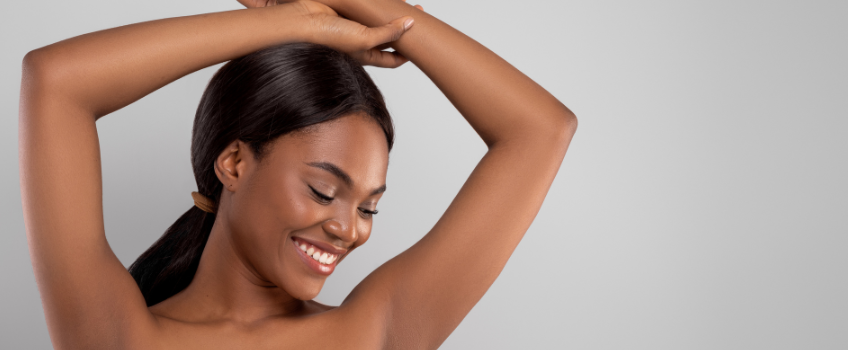
Darkening of intimate areas is a widespread, common and very natural occurrence that is regularly experienced by many women.
This change in skin tone, often perceived as a personal concern, can arise from a variety of factors, including the aging process, hormonal shifts, and certain genetic predispositions. Notably, in areas like the vagina, a high concentration of melanocytes, the cells that are responsible for this visible pigmentation, contributes to this darkening. This process is a normal aspect of bodily aging and typically doesn’t warrant any medical concern.
1. Age-related changes
As you age, your skin undergoes numerous changes in texture, elasticity, and color, often leading to darker pigmentation in intimate areas.
2. Frequent Shaving
Regular shaving can irritate the skin, and the presence of chemicals in shaving products may exacerbate skin darkening. Shaving often causes irritation and inflammation of the skin. This irritation can stimulate melanocytes, the cells responsible for producing melanin (the pigment that gives skin its color). When these cells become overactive, they produce more melanin, leading to darker skin in the shaved area. Shaving can cause tiny cuts or micro-injuries to the skin. The healing process of these injuries often involves the production of extra melanin as a protective response, which can darken the skin. Frequent shaving increases the risk of ingrown hairs, where the hair grows back into the skin instead of up and out. This can lead to inflammation and, subsequently, hyperpigmentation.
3. Genetics
Your genetic makeup significantly influences the natural color of your intimate areas. The amount and type of melanin produced in the body are largely determined by genetics. People with naturally darker skin have more active melanocytes, the cells responsible for melanin production. This increased activity can also lead to more pronounced darkening in intimate areas.
4. Medical Conditions
Medical Conditions: Polycystic Ovary Syndrome (PCOS) and hypothyroidism can lead to skin darkening through a variety of mechanisms, primarily related to hormonal imbalances and metabolic changes. In both PCOS and hypothyroidism, the skin changes are often a result of the body’s response to hormonal imbalances. These hormonal changes can trigger a series of reactions in the skin cells, leading to increased melanin production and subsequent skin darkening. Additionally, both conditions can lead to other skin issues like dryness, acne, or oiliness, further affecting the skin’s appearance and health.
5. Postpartum Changes
Post childbirth, many women observe postpartum skin darkening, particularly around areas like the labia and perineum. This is primarily attributed to hormonal fluctuations and adjustments that occur during and after pregnancy.
6. Friction
Continuous friction from tight clothing can also cause darkening of intimate skin over time. Tight clothing constantly rubbing against the skin creates mechanical irritation. This is especially true for intimate areas where the skin is thinner and more sensitive. In response to this persistent irritation, the skin initiates a protective response. Part of this response involves the increased production of melanin, the pigment that gives skin its color. Melanin is produced as a defense mechanism, as it helps to protect the skin’s deeper layers from damage.
7. Hormonal Changes
Significant hormonal changes during puberty, pregnancy, and menopause can affect melanin production, altering skin color, particularly in the vaginal and nipple areas.
Underarm Darkening: A Parallel Concern
Similar to intimate areas, underarm darkening is a common issue that can impact self-esteem. This condition can arise from:
1. Friction
Caused by tight, non-breathable clothing, especially in individuals with more body weight.
2. Sweat
Excessive sweating, or hyperhidrosis, can lead to underarm darkening through a process that involves bacterial growth and skin irritation. Excessive sweating in the underarms creates a constantly moist environment. This moisture is not just water; it also contains salts and other compounds that are naturally present in sweat. The warm and moist conditions of the underarm are ideal for the growth of bacteria. While some bacteria are naturally present on the skin, the overabundance of moisture due to excessive sweating can lead to an increase in bacterial populations. As bacteria metabolize the compounds in sweat, they can produce substances that irritate the skin. This irritation can lead to inflammation, a natural response of the body to what it perceives as an invasion or injury. Inflammation can stimulate melanocytes, the cells in the skin responsible for producing melanin.
3. Deodorants and Antiperspirants
Some ingredients in these products can react with the skin, causing darkening of the skin. Some deodorants or antiperspirants contain ingredients that may irritate the skin or cause allergic reactions in some individuals. This irritation can lead to darkening of the skin in the affected area. Additionally, many antiperspirants contain aluminum compounds to reduce sweating. These compounds can sometimes react with sweat or clothing, potentially leading to skin discoloration. Finally, some products contain alcohol, which can dry out the skin, leading to irritation and potentially causing darkening.
4. Acanthosis Nigricans
A condition often associated with insulin resistance, leads to darkening of the underarms and other body folds through a series of biological responses.
5. UV Exposure
UV rays can tan or burn the underarms, leading to darker skin. Sun exposure can lead to underarm darkening through a process primarily involving increased melanin production in the skin. Here’s how it happens: When skin is exposed to sunlight, the body naturally increases melanin production as a protective response against harmful ultraviolet (UV) rays. This increase in melanin can lead to darkening of the skin, including the underarm area. The UV rays from the sun can cause damage to the skin cells. In response to this damage, the skin produces more melanin as a defense mechanism. While this helps protect deeper skin layers from further damage, it can also result in darkening or tanning of the skin. Sunburn or inflammation caused by excessive sun exposure can lead to hyperpigmentation. The underarm area, though not typically directly exposed to sunlight, can still be affected, especially if one frequently wears sleeveless clothing. Cumulative Effect: Repeated and prolonged exposure to the sun without adequate protection can lead to a cumulative effect, where the darkening becomes more pronounced over time.
Many women seek non-invasive solutions to lighten and rejuvenate their intimate and underarm areas, driven by a desire for personal confidence and comfort.
The Pink Intimate System: A Solution
An innovative option is the Pink Intimate System, a non-invasive, painless treatment developed in Italy for lightening and rejuvenating areas like the vagina, underarms, nipples, and bikini line.
Advantages:
- Non-invasive and Painless
- Health Canada & FDA Approved
- Suitable for Various Sensitive Areas
- Contains Skin-Soothing Ingredients
- Zero Downtime
Who Can Use It: Anyone seeking to lighten and rejuvenate delicate areas like underarms, inner thighs, bikini lines, areola, labia majora, mons pubis, perianal, and inguinal regions.
Empowering Choices for Skin Care
The Pink Intimate System, among other treatments, represents a shift towards empowering individuals to make choices that enhance their personal comfort and confidence. It’s important to remember that such treatments are options, not necessities, and the decision to use them should always be grounded in personal preference and comfort, not societal pressure or expectations.
Beyond Aesthetics: Celebrating Your Body
It’s essential to recognize that while aesthetic treatments can play a role in how we feel about our bodies, they are just one part of a broader journey towards self-acceptance and body positivity. Celebrating your body, in all its uniqueness, includes both caring for its appearance and embracing its natural changes over time.
Lifestyle Factors and Preventive Care
In addition to considering treatments like the Pink Intimate System, it’s also beneficial to look at lifestyle factors that can contribute to skin health. This includes wearing breathable clothing to reduce friction, practicing gentle skin care routines, and maintaining a healthy diet and hydration for overall skin health.
The Power of Informed Decisions
Ultimately, the decision to pursue treatments for underarm and intimate area darkening rests with you. It’s about making informed choices that align with your values, health, and sense of self. Whether you choose to embrace natural changes or seek treatments for personal reasons, what matters most is that you feel confident and comfortable in your own skin.
Conclusion
The phenomenon of underarm and intimate area darkening is a natural part of our body’s evolution. Understanding its causes and knowing the range of options available, from lifestyle adjustments to treatments like the Pink Intimate System, empowers you to make decisions that best suit your personal health and beauty ideals. Remember, your body is unique, and how you choose to care for it is a deeply personal journey. Celebrate it, care for it, and above all, embrace it with confidence and love.
It’s always prudent to consult a healthcare professional before beginning any new treatment, particularly for sensitive areas. With the right approach, it’s possible to feel more confident and comfortable in your skin.
The journey to embracing and caring for your body, especially in areas as sensitive as underarms and intimate zones, is deeply personal and unique to each individual. Understanding the causes of darkening in these areas is the first step towards making informed choices about your body care routine.
To book your complimentary consultation appointment, call us at 416-548-6548 Book a Consultation
